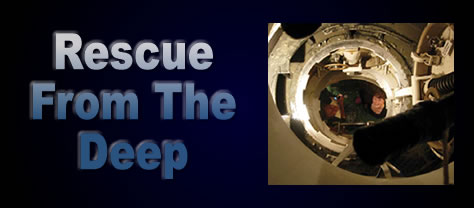A new submarine rescue system, owned jointly by France, Norway and the UK, has successfully completed trials off the coast of Norway. When it comes into service it promises to offer a complete rescue package for trapped submariners, should the unthinkable happen on their submarine, anywhere in the world. The new submersible vehicle will be complement the new US Submarine Rescue Diving and Recompression System based in San Diego. Both are due in service this year, are capable of worldwide deployment and will be available to all submarine-operating nations.
The three countries will also support the new vehicle through its 30 life expectancy at a cost of £157 million. The project is managed by the MOD’s Defence Equipment & Support team on behalf of the three nations. When in service it will based at Faslane on the Clyde and managed by In Service Submarines Integrated Project Team and the existing LR5 rescue submersible and Scorpio remotely operated vehicle will leave operational service.
Designed and built by Perry Slingsby Systems ltd of Kirkbymoorside, the rescue submarine will have a crew of two pilots and an attendant. It is designed to rescue 15 people at a time and will normally operate a four-hour cycle. The vehicle consists of a free-swimming rescue vehicle with an A-frame portable launch and recovery system, a transfer under pressure facility to safely decompress personnel from a pressurized submarine, and an intervention system for survey and rescue preparation. It is powered by advanced sodium nickel batteries with higher power-to-weight/space ratio than traditional lead acid batteries used in current rescue vehicles. Designed to provide time to first rescue target of 72 hours the submarine is designed for air mobility and will be maintained in high readiness status, the submarine will be able to mobilize at a 12 hours’ notice, transported by road and air to a mother-ship destined to operate where a submarine has been sunk. The mother-ship supports the underwater rescue operation by monitoring and guiding the crew through fiber-optic umbilical providing video, communications and data link to the command team on the mother ship.
It will be able to rescue a crew from depths of 40 to 610m, at angles of up to 60 degrees and with internal pressures as high as 6 bar. The vessel is designed to operate at rough sea conditions, and will operate in sea state 6 (5m high waves) and remain on station in 10m high seas. The free-swimming rescue vehicle concluded a successful ‘mate’ with the Norwegian submarine Uredd at a depth of 87 meters in Husnes Fjord, just south of Bergen, last month.
 Initial Trials Verify Basic Submarine Performance
Initial Trials Verify Basic Submarine Performance
“The NATO submarine rescue system is nearing the end of a complex period which has combined design, development, manufacture and demonstration,” said Commander Dickie Burston, leader of Defence Equipment & Support’s NATO Submarine Rescue System team. “It will now move forward and provide the nations with a world class capability.” Last month’s trials were supported by the Harstad, a Norwegian coastguard vessel acting as mother ship. On its deepest dive the rescue vehicle, which has previously been pressure tested to depths of 840 meters, went down in 100m steps to just over 600m with full system checks at each depth. While not all the deep water acceptance trials were completed in full, there were enough key events for the trials to be declared a success. Trials to include testing hatch operations at depth, angled ‘mating’ up to 60 degrees and the ability to recover the vehicle from rough seas will take place soon.
According to Cdr Burston, “Tom Heron, the senior pilot and one of the most experienced submarine rescue operators in the world was delighted with the trial, commenting on the stability, maneuverability and power available and how solid she felt at 610m, with none of the usual creaks and groans heard at great depths.”
Further trials are planned over the next six months. Deployment next month from the MV Argonaute provided by the French Navy will include a two-day medical exercise to test the transfer under pressure facility and develop casualty handling and co-ordination of rescuees. Air portability trials, training and more exercises will continue in the summer and there may be full participation in NATO’s exercise ‘Bold Monarch’ off Norway in late May and early June 2008.
“As a former submarine commander I do not expect submarines to sink, but it is not possible to guard against all eventualities and completely eradicate equipment failure, human error and just plain accidents.” said Cdr Burston, “Submarines still hit uncharted sea-bed pinnacles or have major fires on board and, while the crews manage to get them safely back to port on almost every occasion, if a submarine should sink and some of the crew remain alive on board, it is fundamental that the navies are able to effect rescue. “The submarine rescue system will give us and any other nation that wishes to be associated an outstanding cost-effective solution to the accident that we hope will never happen again.” Burston concluded.
First published in the March 2008 issue of UK MOD Preview magazine.

















